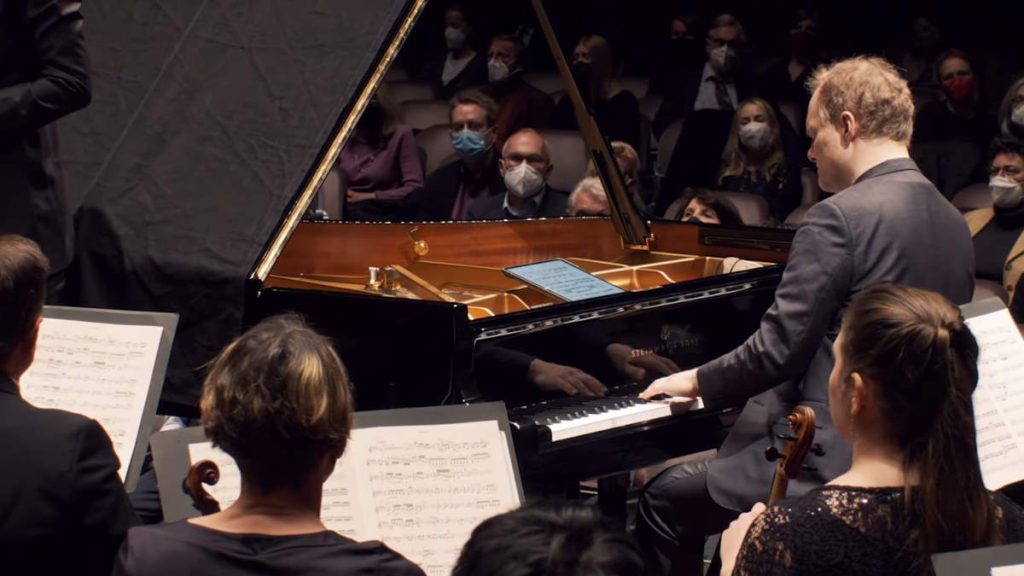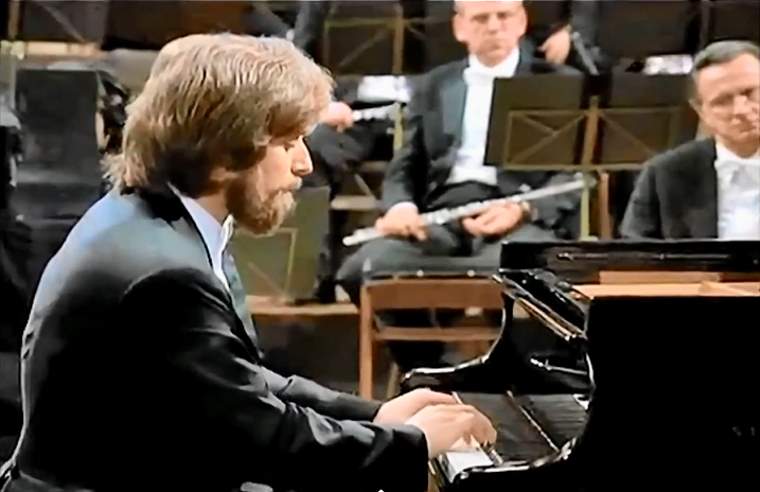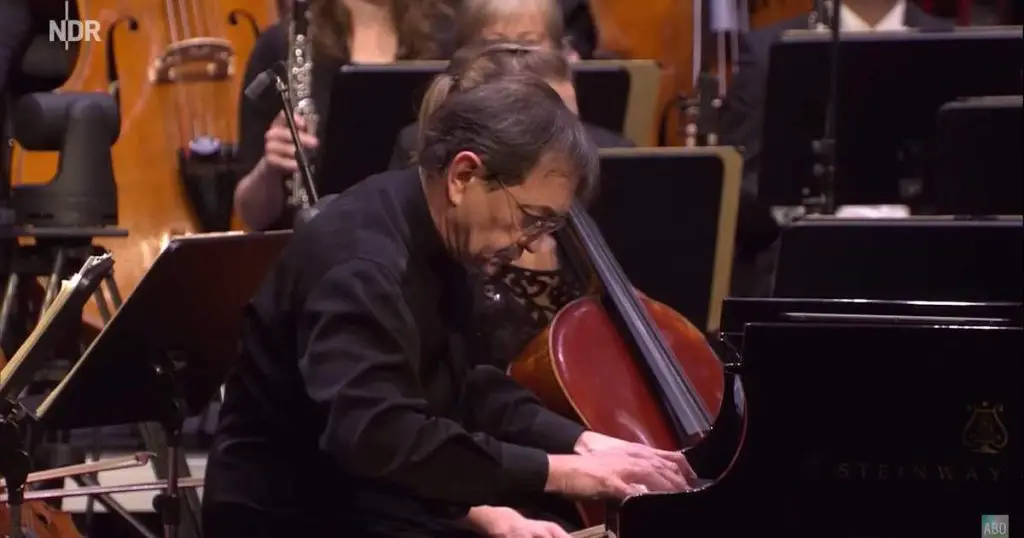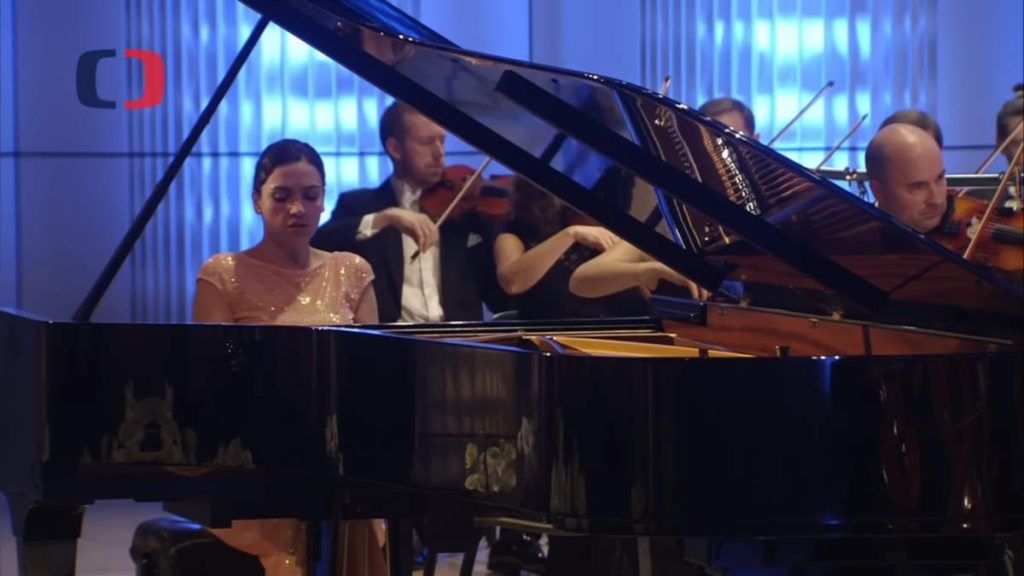Accompanied by the hr-Sinfonieorchester (Frankfurt Radio Symphony Orchestra), the German pianist Lars Vogt (8 September 1970 – 5 September 2022) performs Ludwig van Beethoven’s Piano Concerto No. 3 in C minor, Op. 37. Conductor: Karina Canellakis. This performance was recorded on April 1, 2022, at the Alte Oper Frankfurt.
Ludwig van Beethoven’s Piano Concerto No. 3
Ludwig van Beethoven’s Piano Concerto No. 3 in C minor, Op. 37, is a significant work in the classical music repertoire, showcasing Beethoven’s expanding musical innovation during his middle period. This concerto, composed between 1800 and 1803, marks a transition from the classical style predominantly associated with Mozart and Haydn to a more romantic and personal expression.
The choice of C minor, a key Beethoven was particularly fond of, often associated with a stormy, heroic quality, is reflective of his personal struggles and the turbulent times he lived in. This concerto is noted for its depth of emotion and structural complexity, characteristics that became hallmarks of Beethoven’s later works.
One of the remarkable aspects of this concerto is how it balances the traditional concerto form with Beethoven’s unique stylistic innovations. It maintains the classical three-movement structure typical of concertos but pushes the boundaries in terms of thematic development and orchestration. The orchestral parts are no longer just a backdrop for the soloist; instead, they engage in a dynamic and dramatic dialogue with the piano, a feature that was quite innovative at the time.
The concerto’s first performance was in 1803, with Beethoven himself as the soloist. This was a common practice for composer-pianists of the time. However, Beethoven’s increasing deafness made such performances increasingly challenging for him. The premiere was not entirely successful, partly due to inadequate rehearsal time, which was a frequent issue with Beethoven’s performances.
This concerto’s influence extends well beyond its initial reception. It has been a staple in the concert repertoire and has been recorded by numerous pianists. Its impact is also seen in how it inspired future composers to explore more expressive and dramatic elements in their concerto compositions.
Movements
With start times in the video:
- 0:00 – Allegro con brio
- 16:51 – Largo
- 26:37 – Rondo. Allegro – Presto
1. Allegro con brio
The first movement of Beethoven’s Piano Concerto No. 3 in C minor, Op. 37, is a fascinating blend of classical elegance and the stirring depth of romantic expression. This movement, marked as Allegro con brio, encapsulates Beethoven’s signature style, combining a robust orchestral presence with intricate piano passages.
Characterized by its dramatic and urgent opening, the movement begins with a powerful orchestral exposition. This section introduces the main themes, which are marked by their rhythmic drive and the distinctively Beethovenian use of sudden dynamic contrasts. The themes are developed with a sense of growing tension and complexity, a testament to Beethoven’s mastery in thematic development.
When the piano enters, it does not simply repeat the themes introduced by the orchestra but expands and elaborates on them, showcasing the soloist’s virtuosity and interpretative depth. The piano part in this movement is challenging, demanding both technical prowess and a deep understanding of the underlying emotional currents. The dialogue between the piano and the orchestra is a key feature, with the piano sometimes leading and at other times responding to the orchestra.
One of the most notable aspects of this movement is its use of sonata form. This form typically consists of an exposition, development, and recapitulation, and Beethoven adheres to this structure while also infusing it with his innovative spirit. The development section is particularly remarkable for its intensity and the imaginative way Beethoven manipulates the themes.
Throughout the movement, there is a sense of struggle and resolution, a theme that resonates with many of Beethoven’s works. The movement concludes with a coda that revisits the main themes, providing a sense of closure while also highlighting the movement’s dramatic journey.
2. Largo
The second movement of Beethoven’s Piano Concerto No. 3 in C minor, Op. 37, is a profound and lyrical contrast to the dramatic and turbulent first movement. Marked Largo, this movement unfolds with a serene and introspective quality, showcasing Beethoven’s ability to express deep emotion through his music.
Characterized by its slow tempo and reflective mood, the Largo is a testament to Beethoven’s mastery of lyrical expression. The movement opens with a gentle orchestral introduction, setting a calm and meditative atmosphere. This introduction paves the way for the entry of the piano, which brings a new level of emotional depth and expressiveness.
The piano’s entry is marked by a tender and singing melody, which is one of the movement’s most distinctive features. This melody, played with a sense of profound introspection, is a clear departure from the dramatic and energetic themes of the first movement. The interaction between the piano and the orchestra is more intimate and collaborative in this movement, with the orchestra providing a subtle and supportive backdrop to the piano’s lyrical lines.
Throughout the Largo, Beethoven explores a range of emotions, from tender longing to a more somber and contemplative mood. The use of minor tonalities adds to the movement’s introspective character, while occasional shifts to major keys provide moments of warmth and consolation.
The structure of the movement is relatively simple compared to the complex sonata form of the first movement. However, this simplicity does not diminish its impact; rather, it allows the emotional and lyrical qualities of the music to take center stage. The Largo is an excellent example of Beethoven’s ability to convey profound emotional depth through simplicity and restraint.
3. Rondo. Allegro – Presto
The third movement of Beethoven’s Piano Concerto No. 3 in C minor, Op. 37, marked as Rondo: Allegro, serves as a vivacious and spirited finale to the concerto. This movement is known for its energetic rhythm, playful character, and the brilliant interplay between the piano and the orchestra, bringing the concerto to a triumphant and exhilarating close.
The Rondo form, characterized by the recurring main theme alternating with contrasting episodes, is perfectly suited to the lively and dynamic nature of this movement. The main theme, introduced by the piano, is lively and rhythmic, with a catchy melody that sets the tone for the rest of the movement. This theme is memorable for its clarity and buoyancy, providing a stark contrast to the introspective nature of the second movement.
In typical Beethoven fashion, the movement is full of contrasts and surprises. The episodes between the main rondo theme are varied in character, showcasing both the virtuosity of the soloist and the expressive capabilities of the orchestra. These episodes include moments of lyrical beauty, playful exchanges between the piano and various sections of the orchestra, and passages that highlight Beethoven’s innovative harmonic language.
The piano’s role in this movement is both technically challenging and expressively demanding. The soloist is required to perform rapid passages, intricate fingerwork, and articulate phrasing, all while maintaining a sense of spontaneity and joy. The interaction between the piano and the orchestra is more pronounced in this movement, with the orchestra actively participating in the musical dialogue and enhancing the overall energy and momentum.
One of the distinctive features of this movement is its use of C minor, a key often associated with Beethoven’s more turbulent and dramatic works. However, in this rondo, the minor key does not convey a sense of brooding or melancholy; instead, it adds a dramatic edge to the otherwise lively and jubilant character of the music.
The movement concludes with a spirited coda that revisits the main rondo theme, eventually leading to a triumphant and exuberant finale in C major. This shift to a major key provides a sense of resolution and triumph, effectively concluding the concerto on a high note.
Lars Vogt
Lars Vogt, born on September 8, 1970, in Düren, Germany, was a renowned German classical pianist, conductor, and academic teacher. His talent was globally recognized, especially for his interpretations of Brahms, highlighted by The New York Times. Vogt captivated audiences as a soloist with leading orchestras, notably the Berlin Philharmonic.
At the time of his passing on September 5, 2022, he was the music director of the Orchestre de chambre de Paris and had previously served in the same role with the Royal Northern Sinfonia. Additionally, he was an influential figure in chamber music, founding the Spannungen festival in 1998 and succeeding Karl-Heinz Kämmerling as a piano professor at the Musikhochschule Hannover.
Vogt’s journey in music began at six, culminating in studies under Karl-Heinz Kämmerling at the Hochschule für Musik und Theater Hannover. His rise to prominence was marked by winning second prize at the 1990 Leeds International Piano Competition. This achievement launched a series of significant performances and recordings, starting with Schumann’s and Grieg’s Piano Concertos with the City of Birmingham Symphony Orchestra under Simon Rattle in 1992.
His collaboration with Rattle continued, recording Beethoven’s Piano Concertos Nos. 1 and 2 in 1995. Vogt’s career included performances with prestigious orchestras such as the Royal Concertgebouw, Vienna Philharmonic, and New York Philharmonic, under the baton of Lorin Maazel and later, a residency with the Berlin Philharmonic.

Vogt’s last performance was at the Spannungen festival on June 26, 2022, where he played Brahms’ Piano Quartet No. 3 with renowned musicians including Christian Tetzlaff. He also founded Rhapsody in School, an initiative bringing classical musicians into schools for intimate performances.
Following Kämmerling’s death in 2012, Vogt became a piano professor at the Musikhochschule Hannover. His conducting career began with the Royal Northern Sinfonia in 2015, and in 2020, he was appointed music director of the Orchestre de chambre de Paris, a position he held until his death.
Vogt’s personal life included a marriage to Russian composer Tatjana Komarova and later, a life with his second wife, violinist Anna Reszniak, and their three children in Bavaria. Despite his battle with cancer diagnosed in February 2021, Vogt continued to perform and record.
His death in Erlangen, just days before his 52nd birthday, was a significant loss to the music world. In his memory, a premiere of Jörg Widmann’s piece was held on June 25, 2023.
Vogt’s legacy includes numerous awards like the Brahms-Preis, Echo Klassik, and a posthumous Pablo Casals Award. His recording of Brahms’ Piano Trios was Grammy-nominated, affirming his profound impact on classical music.
Sources
- Piano Concerto No. 3 (Beethoven) on Wikipedia
- Lars Vogt on Wikipedia



